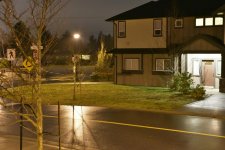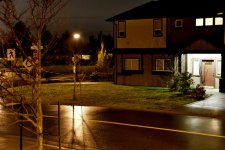You are using an out of date browser. It may not display this or other websites correctly.
You should upgrade or use an alternative browser.
You should upgrade or use an alternative browser.
My D750 over-exposure tendency
- Thread starter TieuNgao
- Start date
rocketman122
Senior Member
what mode did you shoot and what metering did you shoot?
1-metering in cameras suck after so many years. this is something youll have to deal with. be good friends with the EC. FEC as well. youll have to learn to assess the situation and know the dumb camera will over or under. this is something that Ive come to do naturally
2-the camera is a reflective meter, its not always best for a scene/subject you shoot. sometimes you need an incident light metering. both meter in different ways and youll get different exposures for different scenes.
3-just bracket. going back to 1, camera metering sucks and havent advanced at all. put a subject in front of you, a light bulb somewhere in the frame and it will underexpose. youll have to learn to "read" a scene and adjust the exposure.
1-metering in cameras suck after so many years. this is something youll have to deal with. be good friends with the EC. FEC as well. youll have to learn to assess the situation and know the dumb camera will over or under. this is something that Ive come to do naturally
2-the camera is a reflective meter, its not always best for a scene/subject you shoot. sometimes you need an incident light metering. both meter in different ways and youll get different exposures for different scenes.
3-just bracket. going back to 1, camera metering sucks and havent advanced at all. put a subject in front of you, a light bulb somewhere in the frame and it will underexpose. youll have to learn to "read" a scene and adjust the exposure.
My D750 tends to over-expose in low light situations (I haven't checked for normal situations yet).
I have to set exposure compensation at -1.0 to bring the exposure closer to the reality.
Any ideas???
Thanks.
Your cam isn't overexposing, it is doing the job as intended. Grab some white paper and put it in front of the cam, frame it in such a manner it is all white and then use full auto to take a shot. Then do the same with a black paper.
You'll notice the cam nor meter are concerned about the accurate representation of reality when it comes to light, they expose in such a manner your middle tones have a certain "brightness".
I shoot at night a lot, if I would use full auto, those shots at first sight would be indistinguishable from daylight shots.
Once you know how the cam meters and why, you can easily compensate to push it into the direction you want.
And if you shoot a snowy scene using the same metering mode, the camera will underexpose turning those white flakes icky gray. A camera is designed to meter 18% gray (which looks to be about 50% between black and white). That's why you need to override your expose if the majority of the scene is either dark or bright. As was mentioned, an incident meter will give more accurate results. It is a handheld meter. You stand near your subject and aim the incident meter back towards your camera.
For scenes such as this, underexpose and bracket your shots.
For scenes such as this, underexpose and bracket your shots.
Horoscope Fish
Senior Member
As has already been pointed out, your meter doesn't try to replicate what you're eye is seeing; it exposes for middle grey. Overly bright scenes will appear under-exposed and overly dark scenes will appear over-exposed, consistently, because of this. It's the meter balancing things to middle grey. There's an an old adage that says something along the lines of, "If it's bright, go brighter. If it's dark, go darker." This tells us to "over expose" a bright scene or "under expose" a dark scene to compensate for the meter wanting to expose everything to middle grey.
Since you can't train the meter to think differently, the trick is to think like the meter and adjust exposure accordingly.
,,,,
Since you can't train the meter to think differently, the trick is to think like the meter and adjust exposure accordingly.
,,,,
The D750 makes it easy to expose correctly if you use the right metering mode. If your scene has loads of light, use highlight metering and compensate for that. If there's a lot of dark, use matrix. Then for very specific shots, use center or spot metering.
To make it even easier, if you use live-view, you can enable exposure preview (standard disabled) and add the histogram to see how much you can compensate in one of both directions without clipping either side.
To make it even easier, if you use live-view, you can enable exposure preview (standard disabled) and add the histogram to see how much you can compensate in one of both directions without clipping either side.
That highlight metering mode intrigues me. How does it differ from spot metering on a highlight area of a frame?The D750 makes it easy to expose correctly if you use the right metering mode. If your scene has loads of light, use highlight metering and compensate for that. If there's a lot of dark, use matrix. Then for very specific shots, use center or spot metering.
To make it even easier, if you use live-view, you can enable exposure preview (standard disabled) and add the histogram to see how much you can compensate in one of both directions without clipping either side.
Horoscope Fish
Senior Member
That highlight metering mode intrigues me.
All in all... I rate it: Freaking Awesome.
The mode will not *totally* prevent blown out highlights, but it does a very, VERY good job of preserving them; I'd say on order of 90% or better.
....
That highlight metering mode intrigues me.
I find it fantastic for landscapes. It is actually intended for other shots but what I like about it is that it weighs the highlights heavily when metering and because of, my histogram is actually exposed to the left. I then can more accurately use compensation. When using matrix, the shots is pretty balanced and that is the case too for the histogram making changes to exposure a bit harder to control.
My D750 tends to over-expose in low light situations (I haven't checked for normal situations yet).
I have to set exposure compensation at -1.0 to bring the exposure closer to the reality.
Here's the photo taken by the camera:
but the actual scene looks more like this:
Any ideas???
Thanks.
Your camera is doing exactly what it is designed to do and from the images you posted, it's doing it perfectly well. Here's the deal about "proper" exposure - and it's not just cameras in auto/semi mode but rather with ALL PHOTOGRAPHY in general. So, here's the rule you must remember - ie the 18% (or in digital sensors the 12%) rule of "proper exposure."
When "properly" exposed, if you take a picture of a White Cat, it should look like a Grey Cat.
When "properly" exposed, if you take a picture of a Black Cat, it should look like a Grey Cat.
Thus ends the lesson. Keep that in mind and you'll appreciate how the light meter is designed and what it's designed to do! The rest is up to you the photographer - and that's the art of the practice!!!
(Now you understand why it's such a challenge for wedding photographers - expose for the bride"s white gown or the groom's black tux?)
Hope that helps.


